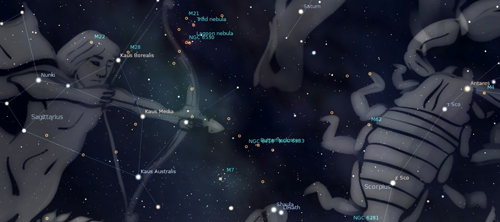
This Week’s Sky at a Glance, July 8 – July 15 ~by Curt Nason
With the Milky Way becoming prominent on summer evenings, binocular stargazing is a great way to pass the time. Save the campfire and ghost stories for cloudy evenings. A good place to start this year is with Saturn, which is as bright as orange Antares to its lower right. If you steady your binoculars on a railing or tripod you might be able to discern the planet’s rings or at least see that it looks elongated. Check out the colour of Antares, and pick out the globular cluster M4 in the same field of view to its right.
Lower left of Saturn is the Teapot asterism that makes up much of Sagittarius the Archer. If you extend the two stars at the top of the teapot’s spout to the right you will find M6, the aptly named Butterfly Cluster. To its lower left is a large star cluster called M7 or Ptolemy’s Cluster. To the right of M7 is a pair of bright stars, Shaula and Lesath, which marks the stinger of Scorpius. They have been nicknamed the Cat’s Eyes.
About a binocular-field width above the teapot’s spout you will find a fuzzy patch with a small cluster of stars in or near it. The fuzzy patch is a cloud of dust and gas called M8, the Lagoon Nebula, where stars are forming. Radiation from hot young stars makes the gas glow, and it can be seen with the naked eye in rural areas. The cluster of stars is called NGC 6530, where NGC stands for New General Catalogue. A telescope will reveal dark dust lanes in the nebula that suggest its lagoon name. Just above M8 is a smaller cloud, M20 or the Trifid Nebula, and the nearby star cluster M21. A large scope will show M20’s dust lanes that separate it into three petals; no relation to the mobile plants that had their day in the 1962 movie based on John Wyndham’s novel.
This Week in the Solar System
Saturday’s sunrise in Moncton is at 5:36 am and sunset will occur at 9:11 pm, giving 15 hours, 35 minutes of daylight (5:45 am and 9:13 pm in Saint John). Next Saturday the Sun will rise at 5:43 am and set at 9:06 pm, giving 15 hours, 23 minutes of daylight (5:51 am and 9:08 pm in Saint John).
The Moon is full on Sunday, the Mi’kmaq Birds Shed Feathers Moon. Mercury sets 70 minutes after sunset midweek but binoculars are recommended to locate it. Jupiter is best observed in the first hour or so after sunset, before it gets too low in the west for steady viewing. Saturn is well placed for observing all evening between Scorpius and Sagittarius. Venus spends the week moving through the Hyades star cluster, which forms the V-shaped face of Taurus the Bull.
The Saint John Astronomy Club meets on Saturday, July 8 at 7 pm in the Rockwood Park Interpretation Centre. All are welcome.
Questions? Contact Curt Nason.
